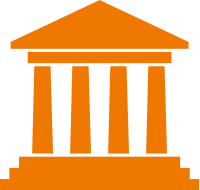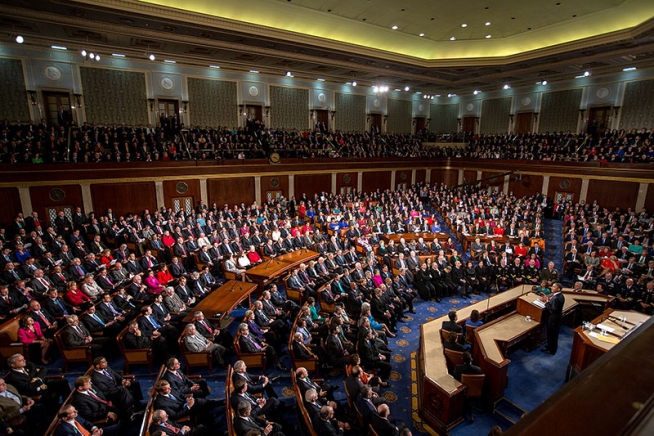
Topics on this page
Image from The New York Times (February 16, 2017)

Federalism
Separation of Powers
- Legislative Branch
- Judicial Branch
- Executive Branch
Checks and Balances
Republican Government or Representative Democracy
Popular Sovereignty
House of Representatives
The Presidency
- The Pardon Power of the President
Net Worth of American Politicians
History of Women, African Americans and LBGTQ Legislators
Focus Question: What are examples of separation of powers, checks and balances and other key constitutional principles in the governments of the United States and the state of Massachusetts?
 Federalism
Federalism
Stanford's Encyclopedia of Philosophy describes Federalism as "the theory or advocacy of federal political orders, where final authority is divided between sub-units and a center.
-
Unlike a unitary state, sovereignty is constitutionally split between at least two territorial levels so that units at each level have final authority and can act independently of the others in some area. Citizens thus have political obligations to two authorities.
Click on the following link to view the text of each of the Federalist Papers.

The System of Checks and Balances
The American government includes an elaborate system of checks and balances to ensure that no one branch has too much power of the other branches.
- As James Madison wrote in Federalist Number 51, "the power surrendered by the people is first divided between two distinct governments [the Federal government and the governments of the several states], and then the portion allotted to each subdivided among distinct and separate departments [the executive, the legislative, and the judicial]."
Paul M Johnson, a political scientist at Auburn University offers the following examples:
- The two houses of Congress may finally agree on a compromise to pass or repeal a law, but the President can veto it.
- President and Congress can agree on passing a law, but if the federal judiciary declares it to be unconstitutional the courts will refuse to treat the law as valid or enforceable.
- The courts can issue orders and injunctions for particular individuals to act or refrain from acting in particular ways, including public officials, but the power of the law enforcement agencies in the executive branch is needed to enforce them if the individuals in question decide to disobey.
- The Congress cannot control the way a judge will rule in a particular case before him, but Congress has the power to define and redefine the jurisdiction of the various federal courts.
- The President has general supervision of the conduct of foreign policy and military policy, but his treaties must be ratified by the Senate before they enter into force, and only Congress can appropriate public money to pay for such things as the raising of an army or the dispensing of foreign aid.
The United States government is divided into three separate branches: legislative, executive, and judicial. This was designed so that the power could not be concentrated in the hands of the few. In order to ensure that the power remained divided, a system of checks and balances was put into place.
The Legislative branch has the following checks and balances:
- On the Judicial branch:
- Senate approves justices
- The House can impeach justices
- The Senate tries impeached justices
- Congress can create amendments
- Congress can set jurisdiction for courts
- Congress can alter the size of the Supreme Court
- On the Executive branch:
- House can impeach a President
- Senate tries impeached an President
- If there is no electoral majority, the House chooses the President and the Senate chooses the Vice President
- Congress can override a Presidential veto with a 2/3 vote in the House and Senate
- Senate approves departmental appointments, treaties, and ambassadors
- Congress has to approve replacements to the Vice President
- Congress declares war
- Congress can tax
- The President is required to make "State of the Union" addresses
- The two different houses of Congress also have checks and balances on each other
- Bills must be passed by each house before becoming law
- Revenue bills must start in the House
- There has to be consent from the other house before a house adjourns for more than three days
- All journals from each house are required to be published
The Judicial branch has the following checks and balances:
- On the Legislative branch:
- Judicial Review
- Compensation is not allowed to decrease
- Judicial seats are held on good behavior
- On the Executive branch:
- Judicial Review
- During impeachment trials, the Chief Justice is President of the Senate
The Executive branch has the following checks and balances:
- On the Legislative branch:
- The President has the power to veto
- The Vice President is the President of the Senate
- The President is the Commander in Chief of the military
- Recess appointments
- The President can make appointments of senior federal officials while the Senate is in recess
- The President can call the House and Senate into emergency sessions
- When the houses do not agree on adjournment, the President has the power to force it
- Compensation is not allowed to decrease
- On the Judicial branch:
- The President can appoint justices
- The President has pardon power
- On the Executive branch:
- The Vice President and the Cabinet has the power to vote the President is incapable of performing his duties

Learning plan on creating your own Law https://www.graphite.org/lesson-plans/how-a-bill-becomes-a-law-create-your-own-board-game
To learn more about the branches of the government and their respective powers, go to Ben's Guide to U.S. Government. Click here for a video explaining the Separation of Powers
Click here for a link to several lesson plans on the concept of the separation of powers, provided by the National Constitution Center.
For more, see Separation of Powers.
All Federal Branches, Smithsonian
Flag of the Speaker of the House of Representatives

The White House has a site describing the three branches
Lesson Plans on Government from the Library of Congress
Documents and their meaning from the National Archives
Legislative Branch
State (Massachusetts)
U.S. Census Bureau has activities exploring states
The official flag of the United States Senate

Federal Judiciary
Federal Courts have a site with educational activities
Crash Course video about checks and balances.
Click on the following link for the Powers of Congress.
Check out a debate in congress between Senators John McCain (R) and Dick Durbin (D)
School House Rock "I'm Just a Bill"
Click here for a fun game about checks and balances.
For more information on the executive branch, see How the President Works from the website, How Stuff Works.
For more about checks and balances, see here (Checks and Balances).
The Impact of the Iroquois Nation on The U.S. Government
Republican Government or Representative Democracy
Democracy in America primarily takes the form of a republican form of government or a representative democracy. Unlike a direct democracy where the people decide every issue (for example, a New England town meeting), in a representative system, the people allow their democratically elected representatives (members of Congress and state legislatures as well as the President and state governors) to make political decisions and choices.
Lesson plan packet for high school for representative democracy.
Popular Sovereignty
As the Ohio Historical Society has noted: popular sovereignty is a political term that simply means that the “people are the rulers.” The concept of rule by the people is central to the American system of government. Issues and questions of national, state and local importance are decided democratically by the will of the people as expressed by their votes in elections. Here is an article from the New York Times that explains popular sovereignty.
House of Representatives

Click here for the 10 (really 12) Most Important Things to Know about the House of Representatives.
Click here for Oral History of the House of Representatives, a collection of interviews with former House staff members.
Click here for a live feed of the House of Representatives when it is in session.
Image of Mount Rushmore stamp, 3-cents, 1952 issue
Smithsonian National Postal Museum/Public Domain

The Presidency
Presidential Powers: An Introduction, from Exploring Constitutional Conflicts
Does the President Have Too Much Power? Aberbeen (Washington) School District
The American Presidency Project
The State of Union Address
Ten Facts about the State of the Union Address, Council on Foreign Relations (January 23, 2019)

Executive Orders by American Presidents

The Presidency Smithsonian
President Barack Obama delivers his State of the Union address to a joint session of the United States Congress
in the Chamber of the House of Representatives, Washington, D.C., Feb. 12, 2013

Republicans Now Are More Open to the Idea of Expanding Presidential Power, Pew Research Center (August 7, 2019)
- Among the public, 66% said "it would be too risky to give U.S. Presidents more power to deal directly with many of the nation's problems"
The Pardon Power of the President
Article 2, Section 2: The President is given the "power to grant reprieves and pardons for offenses against the United States, except in cases of impeachment"
- The power is limited to federal crimes, not state offenses or civil suits
 Pardon Information and Instructions, Department of Justice
Pardon Information and Instructions, Department of Justice
Memorial statue depicting the Whiskey Rebellion, located on Main Street in Washington, Pennsylvania

Why U.S. Presidents Can Pardon Anyone, CNBC (June 6, 2018)
The Long History of Presidential Pardons in the U. S., NPR (March 13, 2019)
How Presidential Pardons Work, How Stuff Works
- The power originated with English kings who could overturn any sentence
- George Washington issued the first pardon in 1794 to Pennsylvania farmers who participated in the Whiskey Rebellion
- Franklin Roosevelt issued the most pardons, 3687 in 3 terms; Harry Truman (2044); Bill Clinton (456); George H. W. Bush (77)
Pardon Powers in the States
 Net Worth of Members of Congress
Net Worth of Members of Congress
For information on the Net Worth of Members of Congress, see Personal Finances from the OpenSecrets website of the Center for Responsive Politics. Data made available under the Stop Trading on Congressional Knowledge (STOCK) Act.
- Median net worth in 2012 was $1,008,767.
- Democrats had higher median net worth ($1.04 million) than republicans ($1 million).
- Net worth of Senators ($2.7 million); House members ($896,000).
- As of 2014 the average net worth of American politicians was $301,000 while the median for all Americans was $45,000. These numbers show the difference between the government and the people they serve.
Map shows the Richest Politician in Every State 2017
Women, African American and LBGTQ Legislators
Hattie Caraway, first elected female senator


- Click here to visit Women in Congress, a website devoted to the 260 women who have served as members of House of Representatives or the Senate.
- Click here to read up on Women running for congress in 2018 & Here for women currently in Congress
Photograph of Edith Bolling Galt Wilson

 |
| Joseph Rainey |
Click here to visit Black Americans in Congress.
Joseph Hayne Rainey, first African American elected to Congress

Senator Tammy Baldwin, 2013

List of the first LGBT Holders of Political Offices in the United States
Meet the 10 Gay, Lesbian and Bisexual Members of the 116th Congress
Senator Tammy Baldwin official website
Oregon Governor Kate Brown official website
Article from the New York Times on openly gay members of Congress (2013)
Comments (0)
You don't have permission to comment on this page.